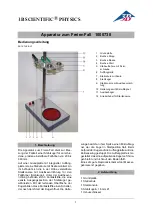
®
ES-9080A
012-07227G
Basic Electrostatics System
33
the voltage across (and the charge on) the capacitor decreases with time according to the
equation
. After a time
t = RC
(one time constant), the voltage across the
capacitor decreases to 37% its maximum value.
3.
Determine how much is 37% of the total voltage and locate where in the discharging plot
this value has been reached. How long a time since the start of discharging did it take to
reach this value? (Use the smart cursor tools!)
4.
Compare this measured
RC
constant with the known value.
Procedure 4B: Charging/Discharging Capacitors with Signal Generator
When a positive square wave signal is applied to a capacitor in an
RC
circuit, the capacitor
periodically charges and discharges, as shown in Figure 4.2. The period of a full charge-
discharge equals the period of the wave.
Note: The procedure listed here specifies values for R, C and the frequency of the signal that work
well together. If you decide to use any other R or C value, you have to adjust the frequency of the
wave. Notice that the voltage has to remain constant for enough time to fully charge the capacitor
before the voltage goes to zero and the capacitor is discharged. A good estimate of the time needed to
fully charge a capacitor can be determined as t = RC[lnV
o
- ln0.01], where V
o
is the voltage of the
source. Choose a signal such that the period of the wave is at least double this charging time.
Experimental Setup
1.
Set up the circuit shown in Figure 4.3, where the resistor and the capacitor are connected in
series to the signal output generator of the
PASCO
750 Interface. Use a 200
F capacitor and
V
V
0
e
l RC
=
Vo
V
Figure 4.2: Charging and Discharging with a Square Wave Signal
Figure 4.3: Experimental Setup
computer
electrometer
analog
channel
interface





















